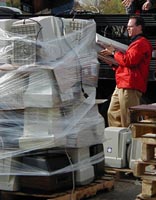
Extended producer responsibility (EPR) is a strategy to add all of the estimated environmental costs associated with a product throughout the product life cycle to the market price of that product, contemporarily mainly applied in the field of waste management. Such societal costs are typically externalities to market mechanisms, with a common example being the impact of cars.
Green computing, green IT, or ICT sustainability, is the study and practice of environmentally sustainable computing or IT.

Electronic waste recycling, electronics recycling ore-waste recycling is the disassembly and separation of components and raw materials of waste electronics; when referring to specific types of e-waste, the terms like computer recycling or mobile phone recycling may be used. Like other waste streams, re-use, donation and repair are common sustainable ways to dispose of IT waste.

Electronic waste or e-waste describes discarded electrical or electronic devices. It is also commonly known as waste electrical and electronic equipment (WEEE) or end-of-life (EOL) electronics. Used electronics which are destined for refurbishment, reuse, resale, salvage recycling through material recovery, or disposal are also considered e-waste. Informal processing of e-waste in developing countries can lead to adverse human health effects and environmental pollution. The growing consumption of electronic goods due to the digital revolution and innovations in science and technology, such as bitcoin, has led to a global e-waste problem and hazard. The rapid exponential increase of e-waste is due to frequent new model releases and unnecessary purchases of electrical and electronic equipment (EEE), short innovation cycles and low recycling rates, and a drop in the average life span of computers.

The electronics industry is the economic sector that produces electronic devices. It emerged in the 20th century and is today one of the largest global industries. Contemporary society uses a vast array of electronic devices built-in automated or semi-automated factories operated by the industry. Products are primarily assembled from metal–oxide–semiconductor (MOS) transistors and integrated circuits, the latter principally by photolithography and often on printed circuit boards.
There is no national law in the United States that mandates recycling. State and local governments often introduce their own recycling requirements. In 2014, the recycling/composting rate for municipal solid waste in the U.S. was 34.6%. A number of U.S. states, including California, Connecticut, Delaware, Hawaii, Iowa, Maine, Massachusetts, Michigan, New York, Oregon, and Vermont have passed laws that establish deposits or refund values on beverage containers while other jurisdictions rely on recycling goals or landfill bans of recyclable materials.
The Energy Biosciences Institute (EBI) is an organization dedicated to developing new sources of energy and reducing the impact of energy consumption. It was created in 2007 to apply advanced knowledge of biology to the challenges of responsible, sustainable energy production and use. Its main goal is to develop next-generation biofuels—that is, biofuels that are made from the non-edible parts of plants and reduce greenhouse gas emissions.

Upcycling, also known as creative reuse, is the process of transforming by-products, waste materials, useless, or unwanted products into new materials or products perceived to be of greater quality, such as artistic value or environmental value.

The Basel Action Network (BAN), a charitable non-governmental organization, works to combat the export of toxic waste from technology and other products from industrialized societies to developing countries. BAN is based in Seattle, Washington, United States, with a partner office in the Philippines. BAN is named after the Basel Convention, a 1989 United Nations treaty designed to control and prevent the dumping of toxic wastes, particularly on developing countries. BAN serves as an unofficial watchdog and promoter of the Basel Convention and its decisions.

Sims Limited (formerly Sims Metal Management Limited) is a global environmental services conglomerate, operating through a number of divisions, with a focus on: (a) Ferrous and Non-ferrous metal recycling, (b) enterprise data destruction and cloud asset management (c) post-consumer electronic goods recycling and reuse, (d) municipal waste recycling, (e) gas to energy, and (f) waste to energy. Founded in 1917, its primary operations are located in the United States, Australia and the UK.
The Silicon Valley Toxics Coalition (SVTC) was formed in San Jose, California- as a research and advocacy group that promoted safe environmental practices in the high tech industry. The organization was founded in 1982 after leaks at manufacturing sites at IBM and Fairchild Electronics were suspected of causing widespread birth defects and health issues in the Silicon Valley.
Solving the E-waste Problem (StEP) is a membership organization that is part of United Nations University and was created to develop solutions to address issues associated with electronic waste. Some of the most eminent players in the fields of Production, Reuse and Recycling of Electrical and Electronic Equipment (EEE), government agencies and NGOs as well as UN Organisations count themselves among its members. StEP encourages the collaboration of all stakeholders connected with e-waste, emphasising a holistic, scientific yet applicable approach to the problem.

Electronic waste or e-waste in the United States refers to electronic products that have reached the end of their operable lives, and the United States is beginning to address its waste problems with regulations at a state and federal level. Used electronics are the quickest-growing source of waste and can have serious health impacts. The United States is the world leader in producing the most e-waste, followed closely by China; both countries domestically recycle and export e-waste. Only recently has the United States begun to make an effort to start regulating where e-waste goes and how it is disposed of. There is also an economic factor that has an effect on where and how e-waste is disposed of. Electronics are the primary users of precious and special metals, retrieving those metals from electronics can be viewed as important as raw metals may become more scarce

Electronic waste is a significant part of today's global, post-consumer waste stream. Efforts are being made to recycle and reduce this waste.

Mobile phone recycling describes the waste management of mobile phones, to retrieve materials used in their manufacture. Rapid technology change, low initial cost, and planned obsolescence have resulted in a fast-growing surplus, which contributes to the increasing amount of electronic waste around the globe.

The e-Stewards Initiative is an electronics waste recycling standard created by the Basel Action Network.

The Gies College of Business Instructional Facility (BIF) is a state-of-the-art business facility designed by Pelli Clarke Pelli Architects located on the Champaign campus at the University of Illinois Urbana–Champaign (UIUC).

A circular economy is a model of production and consumption, which involves sharing, leasing, reusing, repairing, refurbishing and recycling existing materials and products for as long as possible. CE aims to tackle global challenges such as climate change, biodiversity loss, waste, and pollution by emphasizing the design-based implementation of the three base principles of the model. The three principles required for the transformation to a circular economy are: designing out waste and pollution, keeping products and materials in use, and regenerating natural systems." CE is defined in contradistinction to the traditional linear economy. The idea and concepts of circular economy (CE) have been studied extensively in academia, business, and government over the past ten years. CE has been gaining popularity because it helps to minimize emissions and consumption of raw materials, open up new market prospects and, principally, increase the sustainability of consumption and improve resource efficiency.
The Prairie Research Institute is a multidisciplinary research institute charged with providing objective research, expertise, and data on the natural and cultural resources of Illinois. It was established as a unit of the University of Illinois at Urbana-Champaign by a Public Act of the Illinois State Legislature in 2008. The institute comprises four state scientific surveys: the Illinois Natural History Survey (INHS), the Illinois State Archaeological Survey (ISAS), the Illinois State Geological Survey (ISGS), and the Illinois State Water Survey (ISWS), and the institute also houses the Illinois Sustainable Technology Center (ISTC). The institute has a combined total staff of more than 700 employees, with facilities located on the Urbana-Champaign campus of the University of Illinois, and field offices and research stations throughout the state.

Sustainable electronics are electronic products made with no toxic chemicals, recyclable parts, and reduced carbon emissions during production. "Sustainability is still very new, emerging business concept. Because of that, we lack uniform guidelines or standards applicable per industry sector that can help companies establish best practices."













